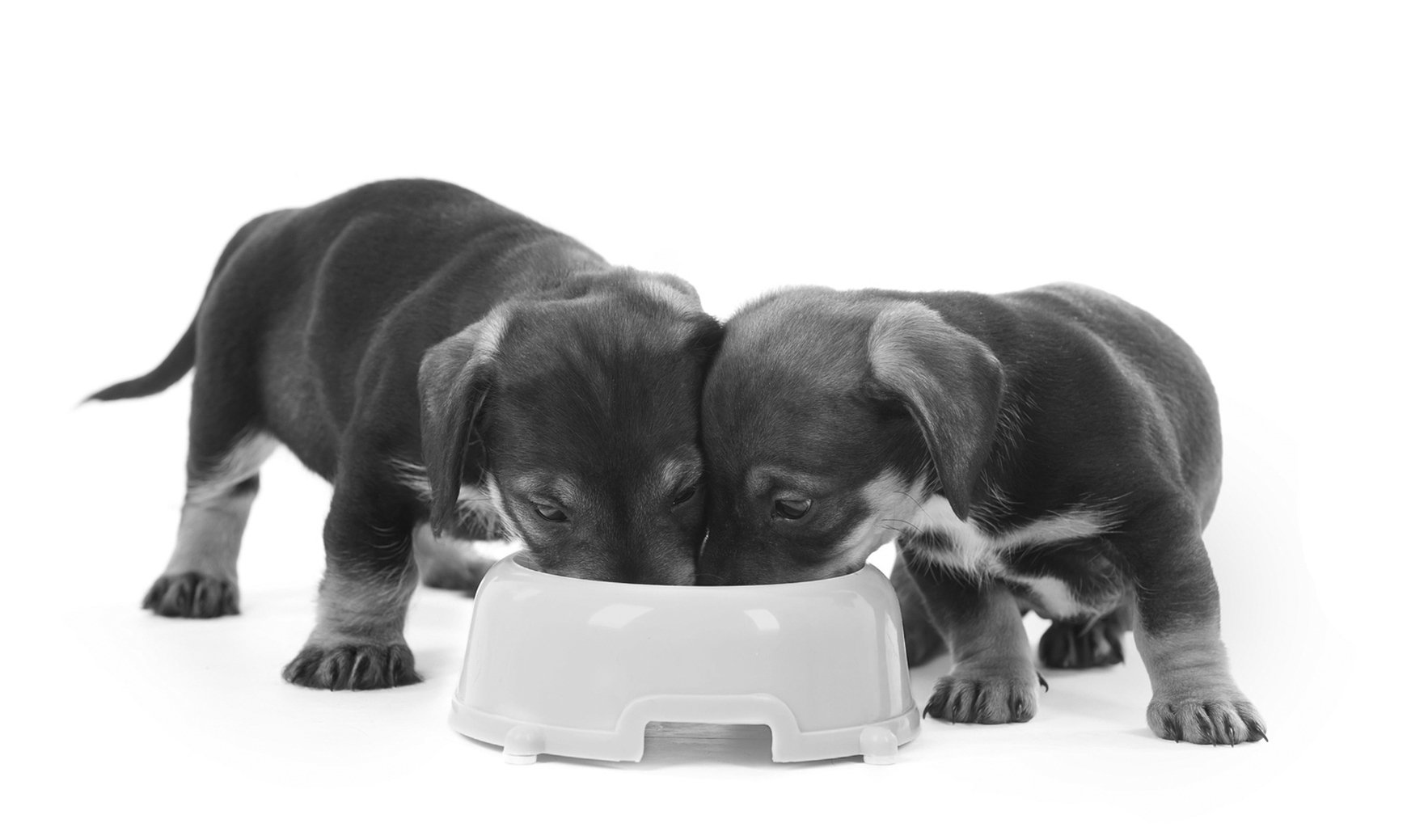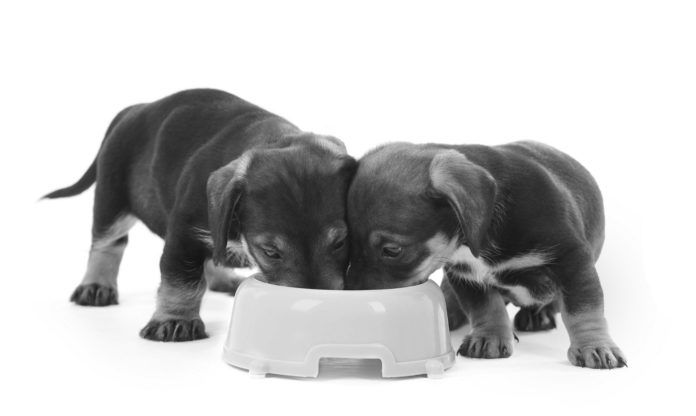“Just the other day we had two brothers — a pair of Chihuahua mixes, tiny little things — who had always eaten out of the same bowl their entire lives,” says Cailin Heinze, VMD, a board-certified veterinary nutritionist at Tufts. “Now they were going to have to eat separately because one of them had a bladder stone that required a very special diet. The owner has come to realize she’s going to have to train them over time to be fed from separate bowls. She had always left out just one bowl with food in it for the two dogs to free feed whenever they wanted, and that’s no longer going to work. The dogs may resist — refusing separate dining bowls and even going hungry — but she knows she has to put their health concerns first.”
Difficulty feeding animals differently is more common in cats, veterinary nutritionists agree, but there are still plenty of scenarios in which dogs require separate meals, and making the change from leaving out the same food for both of them can present challenges. Fortunately, Dr. Heinze says, the difficulty tends to be an emotional one on the part of the owner rather than a logistic one. “Owners often feel nervous about changing their dogs’ lifestyle from whatever it was,” Dr. Heinze comments. “Or they fear that one of the dogs will feel he’s not getting as good an offering as another pet. We have clients all the time who say, ‘I can’t let this one think he’s getting something better than the other dog,’ or vice versa. But it’s not like human kids. Dogs might feel bad for a moment, but I don’t know that they hold onto it. They eat and move on. If you need two dogs in the same household to eat different food for their health — perhaps one has kidney disease or another condition that requires a therapeutic food — there are ways to make it happen.”
Bigstock

Reframing Your Dogs’ Mealtime
The three things you need to do to make sure your dogs eat separate food, if necessary, involve 1) supervision or separation, 2) mealtime feeding only rather than free feeding, and 3) firmness.
Supervision/Separation. If, for health reasons, one of your dogs needs to eat a different food, or less food or more food, than your other dog, gone are the days where you can put out the provisions, walk away from the food bowls, and let the pets work it out. Like children, each dog will want the food he hasn’t been given; he’ll perceive it as more special than the kibble you doled out to him. Thus, you need to stand there and watch the dogs while they eat, making sure each sticks to his own rations. If that proves impossible, separating your pets at mealtime is in order.
One option for meal separation, Dr. Heinze says, is to put up a baby gate between two rooms. The two dogs will still be able to see each other, she says, “but the gate doesn’t come down until they’ve both finished their food.”
A doggie door might also do the trick — one that’s big enough for a small dog but not a bigger one. That way, the larger dog can’t get at the smaller one’s food bowl.
Deborah Linder, DVM, a colleague of Dr. Heinze who heads our Obesity Clinic for Animals, says that yet another possibility for keeping the peace is to take one dog on a walk while the other is eating. She especially likes this tactic when there’s an overweight dog who needs to eat a different, low-calorie food or simply less food than the other dog — because it introduces exercise while cutting calories.
“What I also deal with a lot,” Dr. Linder says, “is a situation in which one dog takes longer to eat than the other. To avoid conflict between the two dogs, let the one who eats more slowly start first.” You can also slow down the gulper, she says. “There are dog food bowls with plastic ‘fingers’ sticking up so the dog has to nose around to get the food out.” Dr. Linder also advises that a dog who eats more quickly than his housemate and therefore might be tempted to try to get at the other dog’s food once he finishes his own can be given his food in “dispensing” toys — plastic cubes or eggs or other interactive gadgets “where the dog has to nudge them around to get the food out.”
Mealtime Feeding Only. Of course, feeding two dogs separately and supervising their separate meals means that leaving food out and letting the animals eat ad libitum is not an option. The last thing you want is for a dog with kidney disease to get into the other dog’s “dining room” and be eating your healthy dog’s over-the-counter food, which is going to be too high in certain nutrients for his ailing kidneys. You don’t want your healthy dog to be eating the diet for kidney disease, either. For him, that diet is not going to meet his nutritional needs, Dr. Heinze says. Yet you can’t be watching to see who’s eating out of which bowl all day long. Thus, you have to adjust your dogs to eating at mealtime only in order to be able to keep the food — and the bowls —off the floor and out of reach most of the time.
For dogs who are already used to eating at mealtime only or who tend to eat their food all at once, say, Labs or other large breeds with gusto, feeding at specific times isn’t really going to present any problems. But dogs who like to graze and revisit their bowl throughout the day need to be adjusted to mealtime eating. You can do it over a couple of weeks, Dr. Heinze says. “Start by leaving the bowls out four hours in the morning and four hours in the evening,” then gradually bring it down to 15 minutes for breakfast and 15 minutes for dinner.”
Finicky dogs who don’t like to eat their food all at once may have to be enticed with a food they perceive as particularly delicious — perhaps a canned version of their usual dry kibble.
Firmness. Because we love our dogs so much, it can be hard to force them to change their habits. And let’s face it, dogs train us a lot of the time, manipulating our emotions so they get what they want — when they want it — even to the point of going hungry if they’re not fed the way they’ve become accustomed to being fed. “A healthy Lab is unlikely to purposely starve himself,” Dr. Heinze says, “but sometimes little dogs will hold out, which can be a concern because a smaller dog has fewer reserves for skipping meals.” Even in those cases, however, it’s important to stick to meals rather than free feed when one of the dogs requires a special diet because of a health condition. Just like with children, you have to take care of their physical needs before you tend to their emotional ones. It might be hard not to give in, even when you realize what’s at stake. But the alternative is a sicker dog, which simply isn’t acceptable.
Sometimes You Can Make a Compromise with Your Dogs
If for whatever reason feeding two dogs separately or only at mealtime isn’t going to work, there might sometimes, but not always, be a way to meet the problem in the middle.
“In some cases,” says Dr. Linder, “I’ve come up with an in-between diet. Maybe it’s a very mild disease process for the sick dog, so I can devise a diet that’s somewhere in the middle of ‘therapeutic’ and ‘healthy maintenance’ but that can still help modify the course of the disease and not hurt either dog if left out in bowls. It’s not ideal — I’d rather get the sick dog on a diet that will work best for him — but I’d rather have an owner who complies 100 percent of the time with a diet that’s mostly okay rather than 50 percent of the time with a diet that’s perfect.”
Dr. Heinze sees it the same way. “Let’s say you need to feed a lower-sodium diet to a dog with heart disease,” she says. “You can leave it out for both dogs because less salt won’t be bad for the one with a normal heart. There are probably two dozen or more diets low in sodium that will be okay. A board-certified veterinary nutritionist will be able to tell you which will be good for both dogs.” It’s the same for a dog with an allergy. “If you have one dog with an allergy to, say, beef,” Dr. Heinze points out, “you may be able to feed both dogs diets that don’t contain beef. Dogs don’t have to eat beef.”
It doesn’t always work. A food for a dog with kidney disease might be too low in phosphorus for a healthy dog, for example, theoretically setting up the healthy dog for hemolytic anemia that results from severe phosphorus deficiency, Dr. Heinze says. But in cases where the healthy dog’s health won’t be compromised if he eats the sick dog’s food, you may not have to go the separate-meals route — as long as you don’t mind paying the higher cost of therapeutic food for a dog who doesn’t need it.






We provide several dog care products that match great qual-ity and nutritious values, and we mainly focus on oral care and dental hygiene of dogs.
Great blog post.Helpful and informative tips. I like it thanks for sharing this information with us
I am trying to come up with a 10 stalls to feed each dog.
Do you have any examplesz?